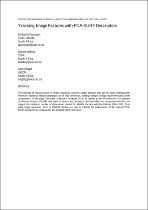JavaScript is disabled for your browser. Some features of this site may not work without it.
- ResearchSpace
- →
- Research Publications/Outputs
- →
- Conference Publications
- →
- View Item
| dc.contributor.author |
Pancham, A

|
|
| dc.contributor.author |
Withey, Daniel J

|
|
| dc.contributor.author |
Bright, G

|
|
| dc.date.accessioned | 2015-10-05T07:23:09Z | |
| dc.date.available | 2015-10-05T07:23:09Z | |
| dc.date.issued | 2015-05 | |
| dc.identifier.citation | Pancham, A, Withey, D.J. and Bright, G. 2015. Tracking image features with PCA-SURF descriptors. In: MVA2015 IAPR International Conference on Machine Vision Applications, May 18-22, 2015, Tokyo, JAPAN | en_US |
| dc.identifier.uri | http://ieeexplore.ieee.org/xpl/login.jsp?tp=&arnumber=7153206&url=http%3A%2F%2Fieeexplore.ieee.org%2Fxpls%2Fabs_all.jsp%3Farnumber%3D7153206 | |
| dc.identifier.uri | http://hdl.handle.net/10204/8149 | |
| dc.description | MVA2015 IAPR International Conference on Machine Vision Applications, May 18-22, 2015, Tokyo, JAPAN. Due to copyright restrictions, the attached PDF file only contains the abstract of the full text item. For access to the full text item, please consult the publisher's website. | en_US |
| dc.description.abstract | The tracking of moving points in image sequences requires unique features that can be easily distinguished. However, traditional feature descriptors are of high dimension, leading to larger storage requirement and slower computation. In this paper, Principal Component Analysis (PCA) is applied to the 64-Dimension (D) Speeded Up Robust Features (SURF) descriptor to reduce the descriptor dimensionality and computational time, and suggest the minimum number of dimensions needed for reliable tracking with the Kalman Filter (KF). Tests using image sequences, from an RGB-D camera, are used to validate the performance of the reduced PCA-SURF descriptors as compared to the standard SURF descriptor. | en_US |
| dc.language.iso | en | en_US |
| dc.publisher | IEEE Xplore | en_US |
| dc.relation.ispartofseries | Workflow;15307 | |
| dc.subject | Image sequences | en_US |
| dc.subject | Traditional feature descriptors | en_US |
| dc.subject | PCA-SURF descriptors | en_US |
| dc.subject | Mobile robots | en_US |
| dc.subject | Principal Components Analysis | en_US |
| dc.subject | PCA | en_US |
| dc.subject | Scale-Invariant Feature Transform | en_US |
| dc.subject | SIFT | en_US |
| dc.title | Tracking image features with PCA-SURF descriptors | en_US |
| dc.type | Conference Presentation | en_US |
| dc.identifier.apacitation | Pancham, A., Withey, D. J., & Bright, G. (2015). Tracking image features with PCA-SURF descriptors. IEEE Xplore. http://hdl.handle.net/10204/8149 | en_ZA |
| dc.identifier.chicagocitation | Pancham, A, Daniel J Withey, and G Bright. "Tracking image features with PCA-SURF descriptors." (2015): http://hdl.handle.net/10204/8149 | en_ZA |
| dc.identifier.vancouvercitation | Pancham A, Withey DJ, Bright G, Tracking image features with PCA-SURF descriptors; IEEE Xplore; 2015. http://hdl.handle.net/10204/8149 . | en_ZA |
| dc.identifier.ris | TY - Conference Presentation AU - Pancham, A AU - Withey, Daniel J AU - Bright, G AB - The tracking of moving points in image sequences requires unique features that can be easily distinguished. However, traditional feature descriptors are of high dimension, leading to larger storage requirement and slower computation. In this paper, Principal Component Analysis (PCA) is applied to the 64-Dimension (D) Speeded Up Robust Features (SURF) descriptor to reduce the descriptor dimensionality and computational time, and suggest the minimum number of dimensions needed for reliable tracking with the Kalman Filter (KF). Tests using image sequences, from an RGB-D camera, are used to validate the performance of the reduced PCA-SURF descriptors as compared to the standard SURF descriptor. DA - 2015-05 DB - ResearchSpace DP - CSIR KW - Image sequences KW - Traditional feature descriptors KW - PCA-SURF descriptors KW - Mobile robots KW - Principal Components Analysis KW - PCA KW - Scale-Invariant Feature Transform KW - SIFT LK - https://researchspace.csir.co.za PY - 2015 T1 - Tracking image features with PCA-SURF descriptors TI - Tracking image features with PCA-SURF descriptors UR - http://hdl.handle.net/10204/8149 ER - | en_ZA |






